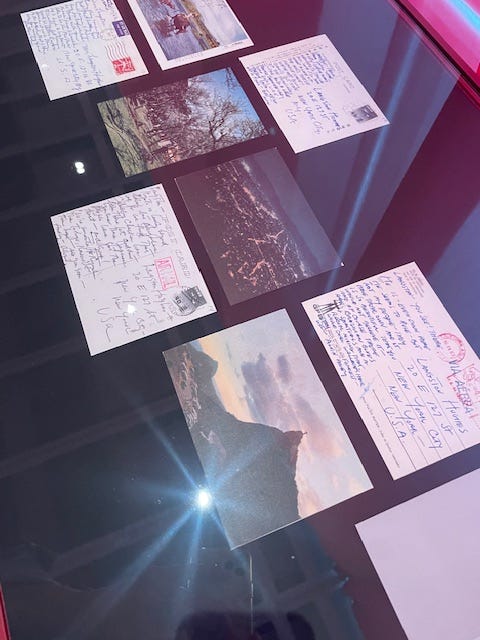October’s for thinking about death
Hey, it’s less stressful than the election! (plus book recs)
“I’m so glad I live in a world where there are Octobers.”
That’s from L.M. Montgomery’s Anne of Green Gables, which I’ve been reading to my kids at night—we are nearly done, three chapters to go.
This fall has been so beautiful and mild here in the Northeast. It’s not only the gorgeous fall colors, but the warm, flattering light. This autumn has been giving summer a run for its money as my favorite season. (I told this to my eight-year-old, Charlie, a fellow “summer born,” as he calls us, and he replied, “GINA!” He only uses my first name when he’s serious/horrified.)
Then Charlie told me that those bright leaves, according to what he learned in school, haven’t actually changed color, they have become the color they were meant to be. Admittedly, I haven’t fact-checked this, but I like the concept: “The leaves are always red, yellow, or orange,” Charlie explained. “The chlorophyll is the top layer, because the sun makes it. So in the fall, the chlorophyll goes down into the trunk and branches, so all that’s left is the leaf's original color.”
If it’s true, then the leaves only get to be their true color for a short time before they die. They’re a gift, an annual visual reminder of death—that, plus Halloween and Day of the Dead. It’s a wistful time of year. In Wilco’s words, emblazoned on my favorite tote bag: “It’s good to be alive. It’s good to know we die.”
Here are the death- and mourning-related things that have been in my vision lately:
*Dirty Laundry, a play at WP Theater on the Upper West Side that’s closing this weekend. I went with my friend Sara, who knows the playwright, and we were both gobsmacked. It’s about processing a mother’s death and a father’s betrayal. It was funny and powerfully, poignantly sad. There was much cathartic sobbing in the audience.
*I’m a fan of Kerry Winfrey’s sweet, funny romance novels and her quirky Substack. She wrote about Liam Payne’s tragic death: “We’re only getting older, baby”
*If you haven’t already seen this, and if you have two minutes and a tissue: Andrew Garfield and Elmo Explain Grief.
*Sara and I have been on a cultural tear! We saw the Alvin Ailey exhibit at the Whitney, and I found his ephemera so affecting—notebooks that shed light on his creative process, postcards he wrote to Langston Hughes. As I was lingering over his letters, I started thinking about how I wished everyone could have a posthumous exhibit like this. Imagine if there was a death curator, who could go through a person’s stuff in an attempt to make sense of a life—to create a thesis about what they stood for, what they contributed, who they influenced and who influenced them. (Anyone else have bizarre, almost psychedelic thoughts at museums?)
This death-curator train of thought reminded me about a passage in my book, which is about (in case you are new here) the year I sent out 365 gratitude notes: “Deathbed regrets are mostly stuff you didn’t do or didn’t say. This project has been my way of saying everything. I’m leaving a paper trail.”
And, hey, maybe you know someone who is in mourning. If you do, let this be your reminder to say something. Better yet, write something in a card.
You don’t know what to say/write, and that’s okay—no one does! Try to stay away from platitudes about better places. You can’t make the pain go away, and that’s not your job. Know that saying anything is (almost) always better than saying nothing. Same rules as when someone has been laid off. That link is from my most popular newsletter to date; here’s the gist: “Perceived awkwardness gets in the way of being human when it matters.”
In chapter five of my book, I talk about how, if you knew the person who died, you can write a condolence card in the same way you would a thank you card. “Ideally, they shed light on the deceased by sharing a specific memory,” I wrote. “It’s a final thank you to the person who is gone, addressed to their loved ones.”
Okay, I swear to you I am not making this up. I started this newsletter draft on Monday, with three chapters left in Anne of Green Gables. I had not read the book in 25ish years and did not remember that the book ended with a sad, poignant death, which we read last night.
I had glanced ahead and knew what was coming, so I read it to the boys just after dinner instead of right at bedtime. I didn’t want to leave them with the image of a dead person and their gray skin when they were in bed. And I gave them the choice; I told them it was a sad chapter, and they both said they wanted to hear it. They handled it much better than I’d imagined. I was the only one who teared up, when the normally strict and taciturn Marilla comforts Anne in her grief and says: “I love you as dear as if you were my own flesh and blood, and you have been my joy and comfort ever since you came to Green Gables.” Sniff! I love this book! More below, in my list of books with “capacious hearts,” in the words of Kate DiCamillo. Which is what we all need right now!
I’m going to end this with one last, most important thing: PLEASE MAKE A PLAN TO VOTE. VOTE EARLY IF YOU CAN! And do something—make some calls, donate some cash. Tomorrow night I am hosting friends and together we are writing 100 letters to Michigan voters (buoyed by Detroit pizza, Greek salad, and Vernors pop— iykyk!).
Xoxo
Gina
BOOKS WITH CAPACIOUS HEARTS
Anne of Green Gables, L.M. Montgomery
It’s hard to believe Anne of Green Gables was published in 1908. So much of it feels so current, down to the puffed sleeves.
The book has so many perfect lines—“Marilla, isn’t it nice to think that tomorrow is a new day with no mistakes in it yet?”—and so funny. About those puffed sleeves and fashion in general: “I’ll be able to study better because of mine. I shall have such a comfortable feeling deep down in my mind about that flounce.”
The boys and I feel so close to Anne as a character. She’s a “kindred spirit,” in her own parlance: “Miss Barry was a kindred spirit after all,” Anne confided to Marilla. “You wouldn’t think so to look at her, but she is. You don’t find it right out at first, as in Matthew’s case, but after awhile you come to see it. Kindred spirits are not so scarce as I used to think. It’s splendid to find out there are so many of them in the world.” (PS: If you’ve read this far, you and I are kindred spirits. Thank you.)
Louise Penny’s Inspector Gamache series
With Halloween approaching, I am getting into my cozy murder mystery reading season, and, perfect timing, the new Louise Penny comes out on October 29th. I’ve preordered from Books Are Magic, and I plan to bring it up to my in-laws’ place in the ethereally beautiful Berkshires over Veterans’ Day weekend (if I can wait that long) and light a fire and read for hours and pretty much be, as my older son Henry says, living my best life.
If you like your murder mysteries cozy, consider this a hard recommend for Louise Penny. Start with the first of her Inspector Gamache books, Still Life. The books take place in a magical little village just south of Montreal, and you can truly taste the cafe au lait and the maple syrup and blueberry crepes and chicken sausages; you can smell the woodsmoke. Her books are only marginally about death; they are mostly about the goodness in people. They’re about life.
(Okay that’s the last book to which I’m linking, due to laziness. You can google the rest!)
Sandwich, Catherine Newman
I must have already written about this book, but I truly can’t recommend this slim novel enough. The main character is brimming full of menopause-enhanced emotions (rage, love) at an annual Cape Cod vacation, sandwiched between grown children and aging parents. Cried and laughed my way through this in one day.
Hello Beautiful, Ann Napolitano
Just gorgeous, start to finish. Worth the hype and more.
Slow Dance, Rainbow Rowell
She’s a master of fleshing out characters. I loved watching these two old friends finally fall in love.
The Friday Afternoon Club, Griffith Dunne
I listened to this on audio, and Dunne teared up a few times talking about his murdered sister and his Hollywood upbringing. It’s not only sad—it’s also funny, sexy, honest. A lot of heart!
The Tale of Despereaux, Kate DiCamillo
For years I’ve been reading mostly Newbery Award books to the kids, so many of which have been bangers. This is on our top five, and it’s the source of the term “capacious heart.” Kate’s is the most capacious, and that’s on stunning display here.
(Remember, vote! And remind others to as well!)








Shortly after my mom died, a message popped up for her on Facebook. A student of hers from her brief stint teaching in the seventies had tracked her down to thank her for the impact she had on her life. Some forty-five years later, the ripples of their interactions were still reverberating. This stranger, who knew a version of my mom that predated me, shared stories of the vary nature you're describing.
It certainly doesn't take away the pain of grief, but it kindles a piece of the person you love back to life. In this way, we never really die. We live on through the lives we have touched.
Wonderful post and heart-expanding (considering the title, which was intriguing but didn’t promise a happy read.) I’m adding some of these titles to my TBR list. Anne is a beloved character in my family too — and I’ve known we were kindred spirits since I read your book 😘.